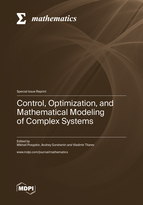Control, Optimization, and Mathematical Modeling of Complex Systems
A special issue of Mathematics (ISSN 2227-7390). This special issue belongs to the section "Mathematics and Computer Science".
Deadline for manuscript submissions: closed (31 December 2021) | Viewed by 49635
Special Issue Editors
Interests: discrete optimization; global optimization; parallel programming; multi-objective optimization; complex systems
Special Issues, Collections and Topics in MDPI journals
Interests: machine learning; neural networks; semiparametric models; stochastic models; mixture distributions; computational statistics; data analysis
Special Issues, Collections and Topics in MDPI journals
Interests: computational fluid dynamics; numerical analysis; parallel computing; computational physics; rarefied gas dynamics
Special Issues, Collections and Topics in MDPI journals
Special Issue Information
Dear Colleagues,
Complex systems have long been an integral part of modern life and can be encountered everywhere. A comprehensive study of such systems is a challenging problem, which solution is impossible without the use of contemporary mathematical modeling techniques. Mathematical models form the basis for optimal design and control of complex systems.
This Special Issue will focus on recent theoretical and computational studies of complex systems modeling, control, and optimization. Topics include but are not limited to
- numerical simulation in physical, social, and life sciences
- modeling and analysis of complex systems based on mathematical methods and AI/ML approaches
- control problems in robotics
- design optimization of complex systems
- modeling in economics and social sciences
- stochastic models in physics and engineering
- mathematical models in material science
- multiscale modeling
- high performance computing for mathematical modelling
Cross-border modeling and numerical simulation in Physics and Engineering are particularly welcome in this Special Issue.
Prof. Dr. Mikhail Posypkin
Dr. Andrey Gorshenin
Prof. Dr. Vladimir Titarev
Guest Editors
Manuscript Submission Information
Manuscripts should be submitted online at www.mdpi.com by registering and logging in to this website. Once you are registered, click here to go to the submission form. Manuscripts can be submitted until the deadline. All submissions that pass pre-check are peer-reviewed. Accepted papers will be published continuously in the journal (as soon as accepted) and will be listed together on the special issue website. Research articles, review articles as well as short communications are invited. For planned papers, a title and short abstract (about 100 words) can be sent to the Editorial Office for announcement on this website.
Submitted manuscripts should not have been published previously, nor be under consideration for publication elsewhere (except conference proceedings papers). All manuscripts are thoroughly refereed through a single-blind peer-review process. A guide for authors and other relevant information for submission of manuscripts is available on the Instructions for Authors page. Mathematics is an international peer-reviewed open access semimonthly journal published by MDPI.
Please visit the Instructions for Authors page before submitting a manuscript. The Article Processing Charge (APC) for publication in this open access journal is 2600 CHF (Swiss Francs). Submitted papers should be well formatted and use good English. Authors may use MDPI's English editing service prior to publication or during author revisions.
Keywords
- Mathematical modelling
- Control and optimization
- Design optimization
- AI/ML modelling
- Material science applications
- Modelling in economics and social sciences
- Robotics applications
- High performance computing








